by Jason Bodner
November 5, 2024
We’re down to the wire.
The election is over today (we hope). You can complain all you want about the outcome on one condition: you vote! The U.S. is well known for loud opinions but is notoriously bad about participating in the vote.
In fact, the United States has been ranked 139th out of 172 countries in voter participation. The 2020 election was much better than average, as the Biden forces got out the vote. In 2020, the U.S. was ranked #31 in voter turnout with 62.8% — just behind Greece (63.5%) and just ahead of Colombia (62.5%).
Some other interesting election facts: Most nations hold elections on weekends, so you don’t have to miss work. And George Washington blew his entire campaign budget – 50 British pounds – on 160 gallons of liquor, given to 390 potential voters. This had been a tradition in England, then transported to Virginia.
Talk about buying an election!
Whether the final results drag out for weeks, or the final results are clear by midnight, the winner will be known soon. But for now, the race is tight, with Harris recently picking up swing states like Michigan in the latest polls. I used to monitor Nate Silver’s fivethirtyeight.com as a resource for objective data-driven analysis of the polls, yet he got it wrong in 2016 and was surprised, like most were, when Trump won.
That’s why I prefer to turn to the betting markets to see what their expected outcome is. Real money seems more reliable than conflicting and somewhat biased polling techniques from one side or the other.
With many polls showing Harris leading, Trump was quietly the betting favorite by a mile – that is, until just a few days ago. He is still favored to win, at 58.3%, but that is down notably from the high of nearly 64% just last week. The sudden fall from the high reflects Harris’s recent strength in three swing states.
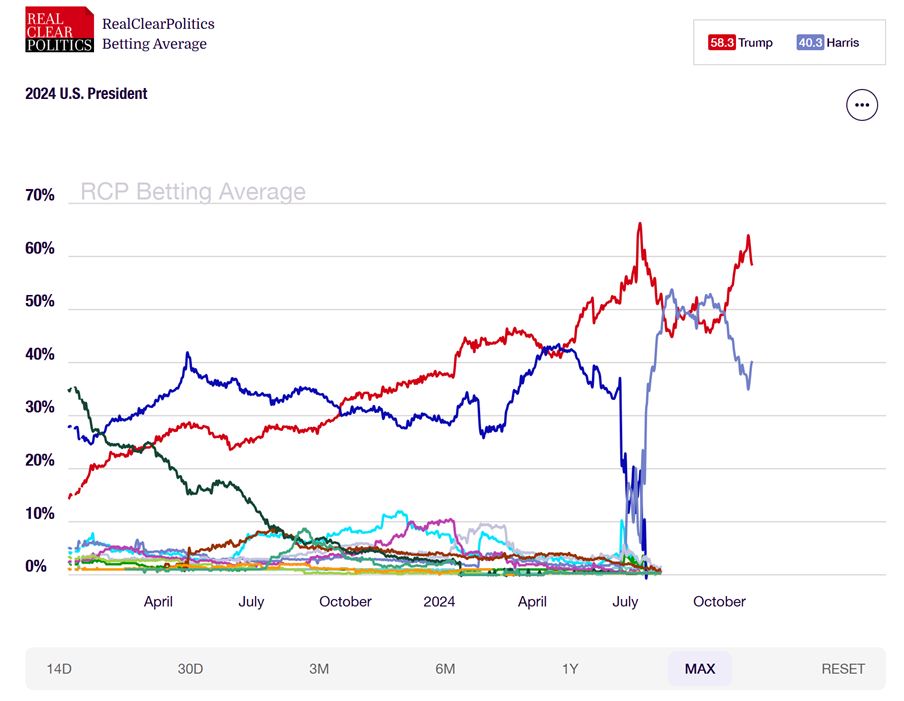
Graphs are for illustrative and discussion purposes only. Please read important disclosures at the end of this commentary.
If the odds tighten and the outcome becomes less certain, it will be no surprise that the stock market keeps gyrating. October volatility may extend to November, hastened by earnings surprises, both good and bad.
Novembers, during election years since 1998, have not delivered any meaningful gains, as the left chart below shows. In fact, we’re more likely to see small losses than major gains in the coming 2-3 weeks, but returns over the following month and following year can be quite rewarding, in all three major indexes:
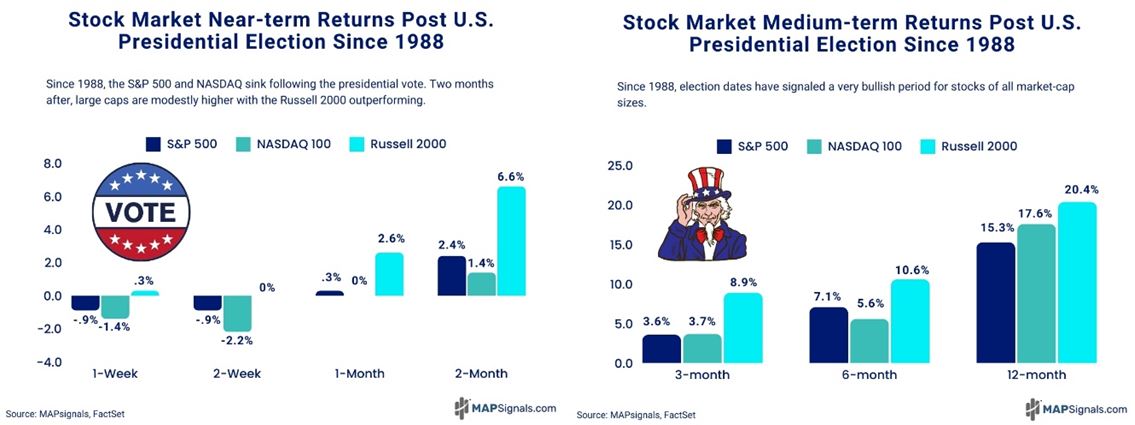
Graphs are for illustrative and discussion purposes only. Please read important disclosures at the end of this commentary.
This uncertainty shouldn’t come as a surprise… we’ve been warning of this for a long time. Just recently, we discussed the Big Money Index (BMI) falling from overbought. Historically, that signals weaker days ahead for stocks. And right on target, after only four days of being overbought, the BMI fell from it on October 21st, and the SPY (the S&P 500 ETF) has fallen 2.1%:
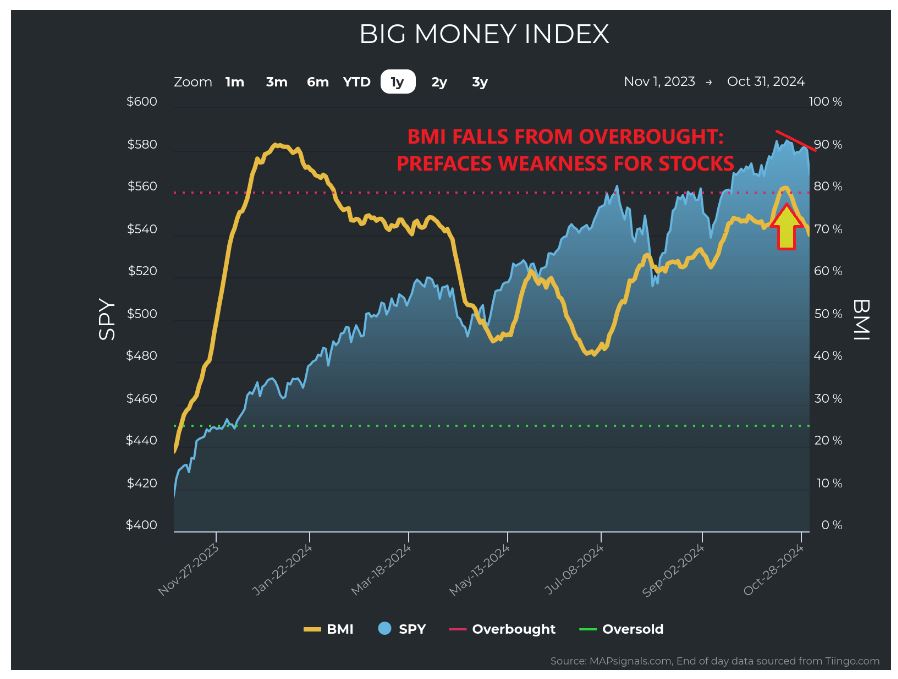
Graphs are for illustrative and discussion purposes only. Please read important disclosures at the end of this commentary.
My initial observation of the BMI falling was that it was not due to increased selling, just a reduction of buying. Well, after a few nasty earnings disappointments, the selling has begun. In fact, last week we witnessed the most selling since early August, which prefaced some ugly price action:
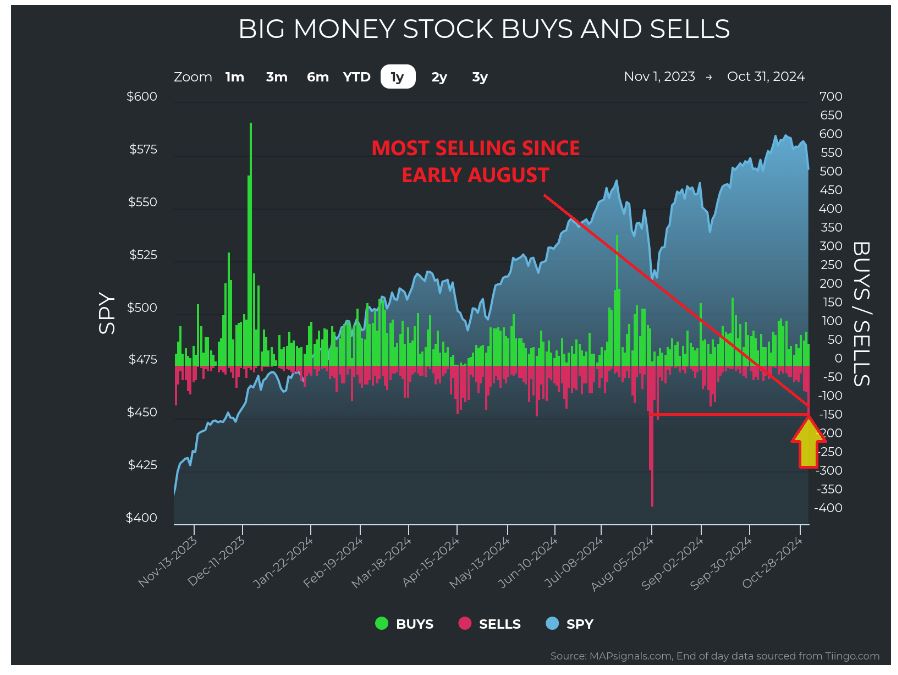
Graphs are for illustrative and discussion purposes only. Please read important disclosures at the end of this commentary.
Interestingly, ETFs saw a small but visible uptick in selling as well:
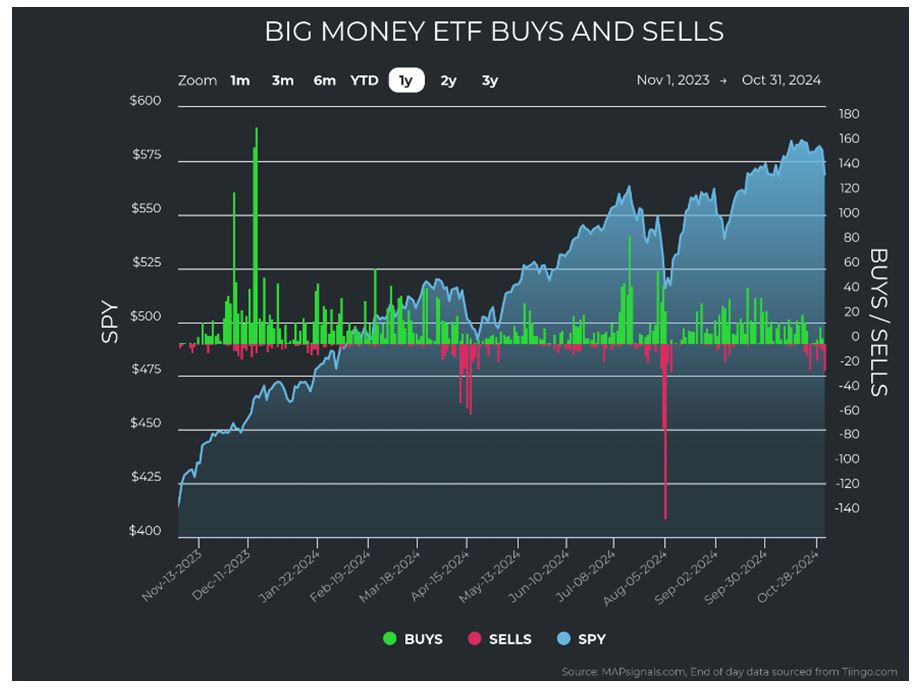
Graphs are for illustrative and discussion purposes only. Please read important disclosures at the end of this commentary.
When we look at individual sectors, we see continued strength in Financials, Utilities, Technology, Industrials, and Discretionary stocks. But we can also see that Real Estate, Communications, Staples, Health Care, and Energy are the laggards:
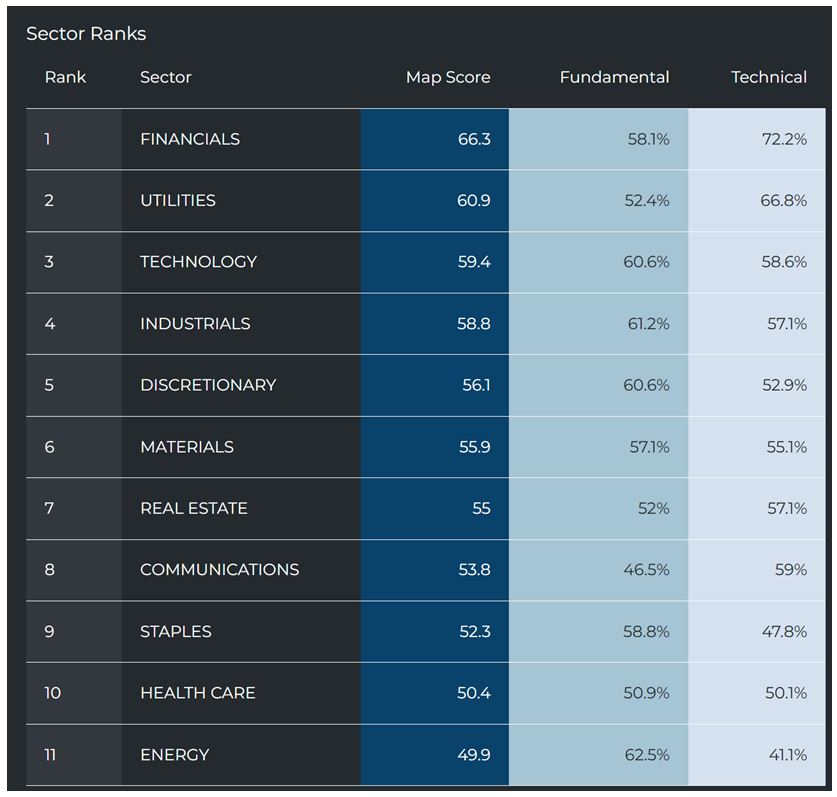
Graphs are for illustrative and discussion purposes only. Please read important disclosures at the end of this commentary.
This is interesting because when we look at the distribution of sectors that are seeing unusually large selling, we see precisely those same five lagging sectors – where most of the selling is concentrated:
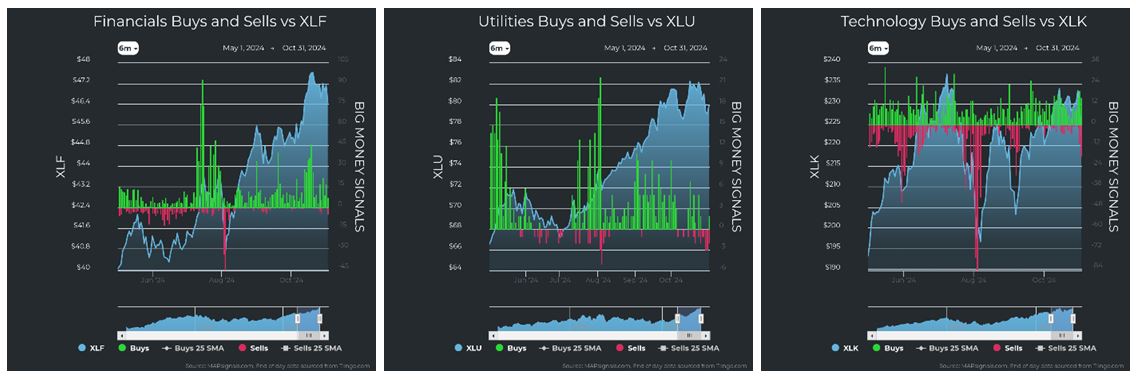


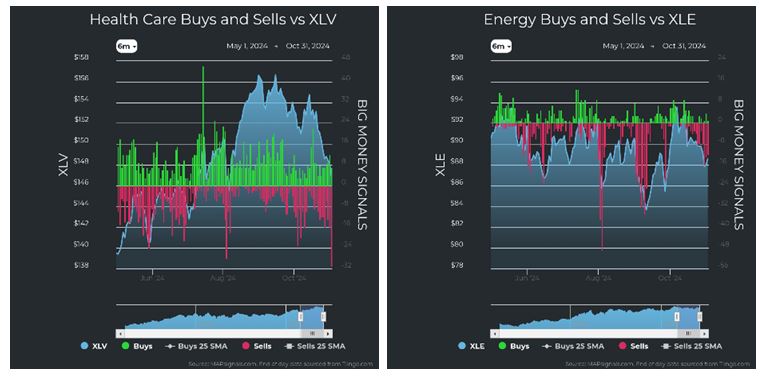
Graphs are for illustrative and discussion purposes only. Please read important disclosures at the end of this commentary.
This is when my nerves start to rattle. Stocks seem vulnerable. Suddenly, I’m hearing rhetoric about overvaluation. I’ve also heard comparisons to “irrational exuberance” of an overheated late-90s market.
Personally, I don’t see it like this – not this time around. I see an overbought BMI falling, indicating weakness ahead, but then we didn’t see the historically expected weak period before the election, either.
Below, we can see each election year since 1992. Notice how the BMI (back then it was a yellow line) falls prior to the election (blue vertical line) practically every time – but not this year.
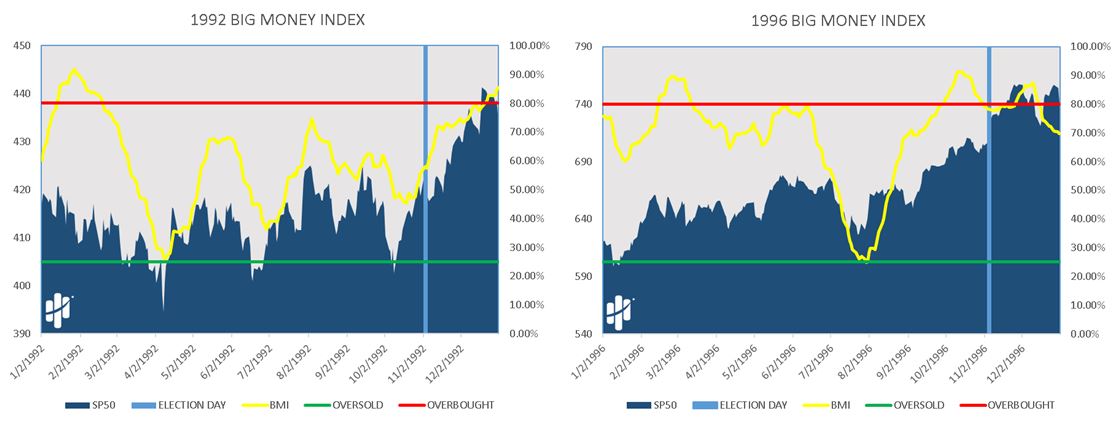
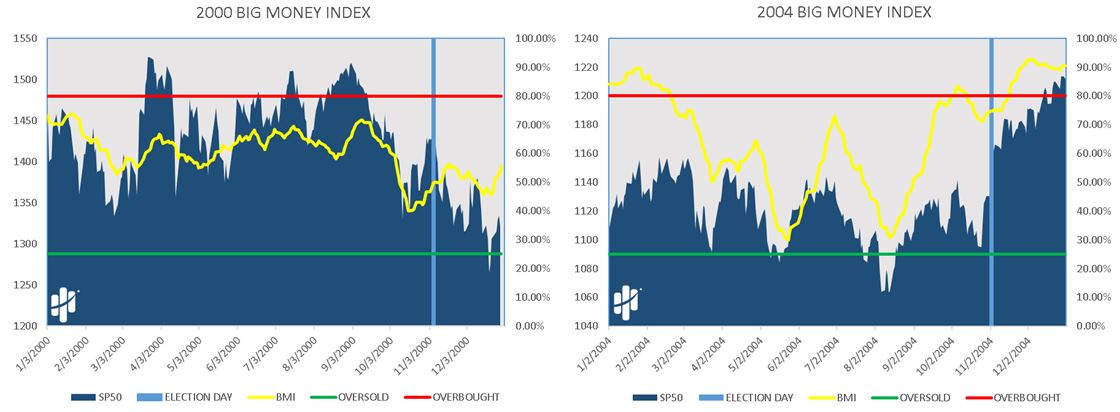
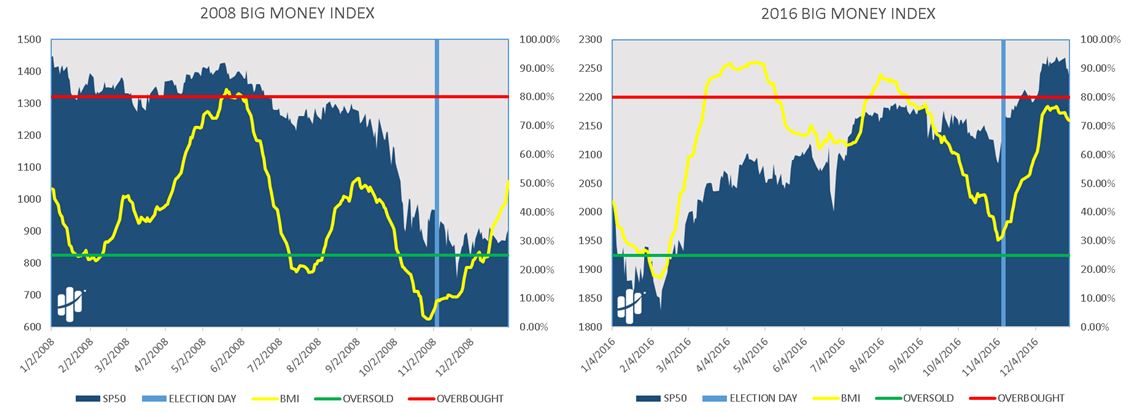
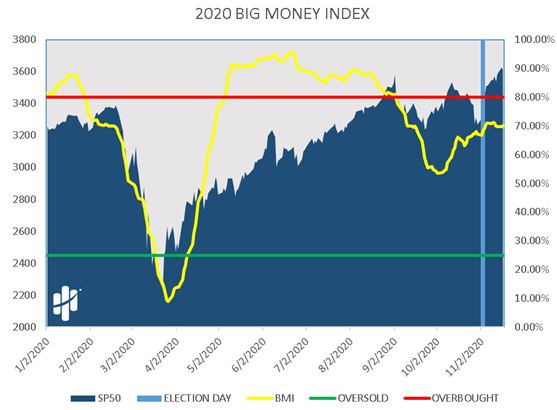
Graphs are for illustrative and discussion purposes only. Please read important disclosures at the end of this commentary.
So, before you let the bears carry you away, you’d best remember that the seasonally strongest time of the year is suddenly upon us. November is the strongest month of the year for stocks, dating back to 1990:
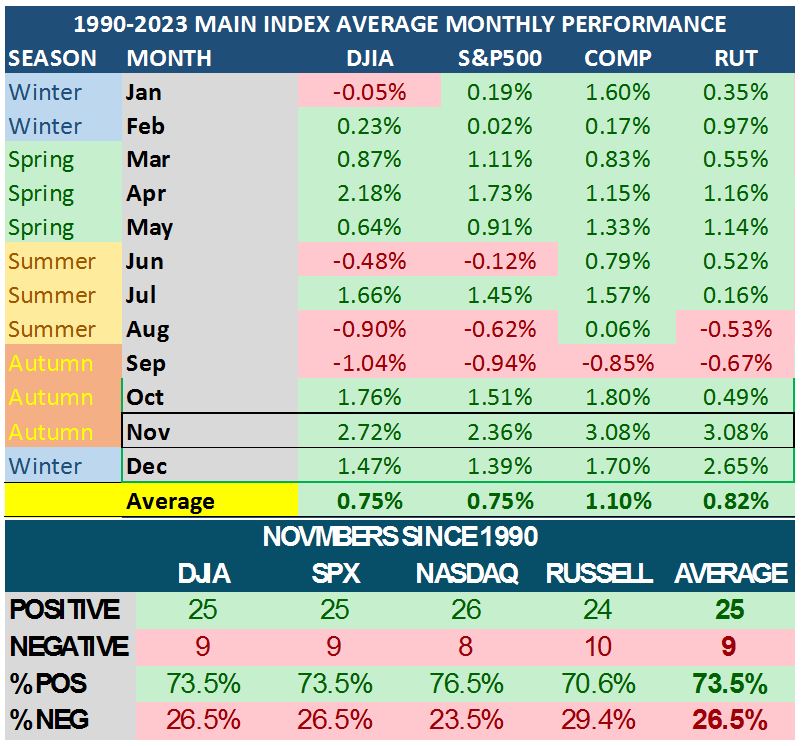
Graphs are for illustrative and discussion purposes only. Please read important disclosures at the end of this commentary.
Looking back at all election years since 1988, we see that we shouldn’t expect too much from the market in the first two weeks after the election, especially if it takes that long to figure out who won, but thereafter, we can expect great things… stretching out a few months later, things look even better. The following chart show that regardless of which party wins, stocks rise well after the first few weeks:
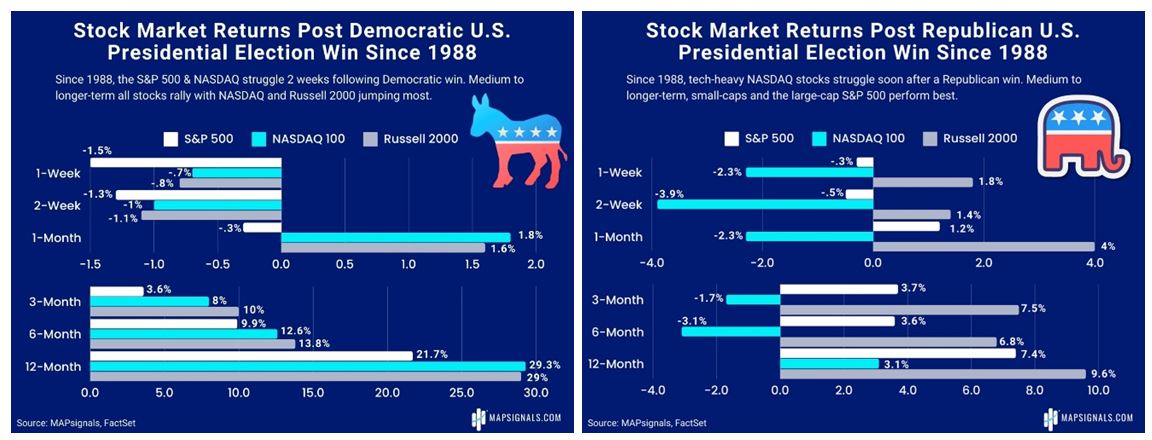
Graphs are for illustrative and discussion purposes only. Please read important disclosures at the end of this commentary.
It is important to take these charts with a grain of salt, as a few very volatile years can skew the overall results significantly. (One need only think of the crisis of 2008 to realize the impact of one terrible year).
In any case, despite a rising 10-year yield recently, interest rate cuts are still widely expected. In fact, the next cut could come as soon as Thursday, which is widely expected to bring us a 25-basis-point cut.
As stocks hit their expected time of volatility, my recommended course of action is to identify the highest scoring stocks and assemble a shopping list, should any of them go on sale. My first stop in hunting for great stocks is looking at the highest-ranking stocks in my institutionally tradeable universe.
Ultimately, the months ahead are typically the strongest months of the year. The data and odds suggest that any dips should be used as buying opportunities. “Plan the work then work the plan.”
Or, as Winston Churchill said, “Let our advance worrying become advance thinking and planning.”
All content above represents the opinion of Jason Bodner of Navellier & Associates, Inc.
Also In This Issue
A Look Ahead by Louis Navellier
Inflation is Down for Now, But What About 2025?
Income Mail by Bryan Perry
Investing In Election-Proof Themes For 2025
Growth Mail by Gary Alexander
What is Growth and What is a Mirage?
Global Mail by Ivan Martchev
The Big Election Week is Finally Here
Sector Spotlight by Jason Bodner
Don’t Expect Any Big Market Moves Right After the Election
View Full Archive
Read Past Issues Here

Jason Bodner
MARKETMAIL EDITOR FOR SECTOR SPOTLIGHT
Jason Bodner writes Sector Spotlight in the weekly Marketmail publication and has authored several white papers for the company. He is also Co-Founder of Macro Analytics for Professionals which produces proprietary equity accumulation and distribution research for its clients. Previously, Mr. Bodner served as Director of European Equity Derivatives for Cantor Fitzgerald Europe in London, then moved to the role of Head of Equity Derivatives North America for the same company in New York. He also served as S.V.P. Equity Derivatives for Jefferies, LLC. He received a B.S. in business administration in 1996, with honors, from Skidmore College as a member of the Periclean Honors Society. All content of “Sector Spotlight” represents the opinion of Jason Bodner
Important Disclosures:
Jason Bodner is a co-founder and co-owner of Mapsignals. Mr. Bodner is an independent contractor who is occasionally hired by Navellier & Associates to write an article and or provide opinions for possible use in articles that appear in Navellier & Associates weekly Market Mail. Mr. Bodner is not employed or affiliated with Louis Navellier, Navellier & Associates, Inc., or any other Navellier owned entity. The opinions and statements made here are those of Mr. Bodner and not necessarily those of any other persons or entities. This is not an endorsement, or solicitation or testimonial or investment advice regarding the BMI Index or any statements or recommendations or analysis in the article or the BMI Index or Mapsignals or its products or strategies.
Although information in these reports has been obtained from and is based upon sources that Navellier believes to be reliable, Navellier does not guarantee its accuracy and it may be incomplete or condensed. All opinions and estimates constitute Navellier’s judgment as of the date the report was created and are subject to change without notice. These reports are for informational purposes only and are not a solicitation for the purchase or sale of a security. Any decision to purchase securities mentioned in these reports must take into account existing public information on such securities or any registered prospectus.To the extent permitted by law, neither Navellier & Associates, Inc., nor any of its affiliates, agents, or service providers assumes any liability or responsibility nor owes any duty of care for any consequences of any person acting or refraining to act in reliance on the information contained in this communication or for any decision based on it.
Past performance is no indication of future results. Investment in securities involves significant risk and has the potential for partial or complete loss of funds invested. It should not be assumed that any securities recommendations made by Navellier. in the future will be profitable or equal the performance of securities made in this report. Dividend payments are not guaranteed. The amount of a dividend payment, if any, can vary over time and issuers may reduce dividends paid on securities in the event of a recession or adverse event affecting a specific industry or issuer.
None of the stock information, data, and company information presented herein constitutes a recommendation by Navellier or a solicitation to buy or sell any securities. Any specific securities identified and described do not represent all of the securities purchased, sold, or recommended for advisory clients. The holdings identified do not represent all of the securities purchased, sold, or recommended for advisory clients and the reader should not assume that investments in the securities identified and discussed were or will be profitable.
Information presented is general information that does not take into account your individual circumstances, financial situation, or needs, nor does it present a personalized recommendation to you. Individual stocks presented may not be suitable for every investor. Investment in securities involves significant risk and has the potential for partial or complete loss of funds invested. Investment in fixed income securities has the potential for the investment return and principal value of an investment to fluctuate so that an investor’s holdings, when redeemed, may be worth less than their original cost.
One cannot invest directly in an index. Index is unmanaged and index performance does not reflect deduction of fees, expenses, or taxes. Presentation of Index data does not reflect a belief by Navellier that any stock index constitutes an investment alternative to any Navellier equity strategy or is necessarily comparable to such strategies. Among the most important differences between the Indices and Navellier strategies are that the Navellier equity strategies may (1) incur material management fees, (2) concentrate its investments in relatively few stocks, industries, or sectors, (3) have significantly greater trading activity and related costs, and (4) be significantly more or less volatile than the Indices.
ETF Risk: We may invest in exchange traded funds (“ETFs”) and some of our investment strategies are generally fully invested in ETFs. Like traditional mutual funds, ETFs charge asset-based fees, but they generally do not charge initial sales charges or redemption fees and investors typically pay only customary brokerage fees to buy and sell ETF shares. The fees and costs charged by ETFs held in client accounts will not be deducted from the compensation the client pays Navellier. ETF prices can fluctuate up or down, and a client account could lose money investing in an ETF if the prices of the securities owned by the ETF go down. ETFs are subject to additional risks:
- ETF shares may trade above or below their net asset value;
- An active trading market for an ETF’s shares may not develop or be maintained;
- The value of an ETF may be more volatile than the underlying portfolio of securities the ETF is designed to track;
- The cost of owning shares of the ETF may exceed those a client would incur by directly investing in the underlying securities and;
- Trading of an ETF’s shares may be halted if the listing exchange’s officials deem it appropriate, the shares are delisted from the exchange, or the activation of market-wide “circuit breakers” (which are tied to large decreases in stock prices) halts stock trading generally.
Grader Disclosures: Investment in equity strategies involves substantial risk and has the potential for partial or complete loss of funds invested. The sample portfolio and any accompanying charts are for informational purposes only and are not to be construed as a solicitation to buy or sell any financial instrument and should not be relied upon as the sole factor in an investment making decision. As a matter of normal and important disclosures to you, as a potential investor, please consider the following: The performance presented is not based on any actual securities trading, portfolio, or accounts, and the reported performance of the A, B, C, D, and F portfolios (collectively the “model portfolios”) should be considered mere “paper” or pro forma performance results based on Navellier’s research.
Investors evaluating any of Navellier & Associates, Inc.’s, (or its affiliates’) Investment Products must not use any information presented here, including the performance figures of the model portfolios, in their evaluation of any Navellier Investment Products. Navellier Investment Products include the firm’s mutual funds and managed accounts. The model portfolios, charts, and other information presented do not represent actual funded trades and are not actual funded portfolios. There are material differences between Navellier Investment Products’ portfolios and the model portfolios, research, and performance figures presented here. The model portfolios and the research results (1) may contain stocks or ETFs that are illiquid and difficult to trade; (2) may contain stock or ETF holdings materially different from actual funded Navellier Investment Product portfolios; (3) include the reinvestment of all dividends and other earnings, estimated trading costs, commissions, or management fees; and, (4) may not reflect prices obtained in an actual funded Navellier Investment Product portfolio. For these and other reasons, the reported performances of model portfolios do not reflect the performance results of Navellier’s actually funded and traded Investment Products. In most cases, Navellier’s Investment Products have materially lower performance results than the performances of the model portfolios presented.
This report contains statements that are, or may be considered to be, forward-looking statements. All statements that are not historical facts, including statements about our beliefs or expectations, are “forward-looking statements” within the meaning of The U.S. Private Securities Litigation Reform Act of 1995. These statements may be identified by such forward-looking terminology as “expect,” “estimate,” “plan,” “intend,” “believe,” “anticipate,” “may,” “will,” “should,” “could,” “continue,” “project,” or similar statements or variations of such terms. Our forward-looking statements are based on a series of expectations, assumptions, and projections, are not guarantees of future results or performance, and involve substantial risks and uncertainty as described in Form ADV Part 2A of our filing with the Securities and Exchange Commission (SEC), which is available at www.adviserinfo.sec.gov or by requesting a copy by emailing info@navellier.com. All of our forward-looking statements are as of the date of this report only. We can give no assurance that such expectations or forward-looking statements will prove to be correct. Actual results may differ materially. You are urged to carefully consider all such factors.
FEDERAL TAX ADVICE DISCLAIMER: As required by U.S. Treasury Regulations, you are informed that, to the extent this presentation includes any federal tax advice, the presentation is not written by Navellier to be used, and cannot be used, for the purpose of avoiding federal tax penalties. Navellier does not advise on any income tax requirements or issues. Use of any information presented by Navellier is for general information only and does not represent tax advice either express or implied. You are encouraged to seek professional tax advice for income tax questions and assistance.
IMPORTANT NEWSLETTER DISCLOSURE:The hypothetical performance results for investment newsletters that are authored or edited by Louis Navellier, including Louis Navellier’s Growth Investor, Louis Navellier’s Breakthrough Stocks, Louis Navellier’s Accelerated Profits, and Louis Navellier’s Platinum Club, are not based on any actual securities trading, portfolio, or accounts, and the newsletters’ reported hypothetical performances should be considered mere “paper” or proforma hypothetical performance results and are not actual performance of real world trades. Navellier & Associates, Inc. does not have any relation to or affiliation with the owner of these newsletters. There are material differences between Navellier Investment Products’ portfolios and the InvestorPlace Media, LLC newsletter portfolios authored by Louis Navellier. The InvestorPlace Media, LLC newsletters contain hypothetical performance that do not include transaction costs, advisory fees, or other fees a client might incur if actual investments and trades were being made by an investor. As a result, newsletter performance should not be used to evaluate Navellier Investment services which are separate and different from the newsletters. The owner of the newsletters is InvestorPlace Media, LLC and any questions concerning the newsletters, including any newsletter advertising or hypothetical Newsletter performance claims, (which are calculated solely by Investor Place Media and not Navellier) should be referred to InvestorPlace Media, LLC at (800) 718-8289.
Please note that Navellier & Associates and the Navellier Private Client Group are managed completely independent of the newsletters owned and published by InvestorPlace Media, LLC and written and edited by Louis Navellier, and investment performance of the newsletters should in no way be considered indicative of potential future investment performance for any Navellier & Associates separately managed account portfolio. Potential investors should consult with their financial advisor before investing in any Navellier Investment Product.
Navellier claims compliance with Global Investment Performance Standards (GIPS). To receive a complete list and descriptions of Navellier’s composites and/or a presentation that adheres to the GIPS standards, please contact Navellier or click here. It should not be assumed that any securities recommendations made by Navellier & Associates, Inc. in the future will be profitable or equal the performance of securities made in this report.
FactSet Disclosure: Navellier does not independently calculate the statistical information included in the attached report. The calculation and the information are provided by FactSet, a company not related to Navellier. Although information contained in the report has been obtained from FactSet and is based on sources Navellier believes to be reliable, Navellier does not guarantee its accuracy, and it may be incomplete or condensed. The report and the related FactSet sourced information are provided on an “as is” basis. The user assumes the entire risk of any use made of this information. Investors should consider the report as only a single factor in making their investment decision. The report is for informational purposes only and is not intended as an offer or solicitation for the purchase or sale of a security. FactSet sourced information is the exclusive property of FactSet. Without prior written permission of FactSet, this information may not be reproduced, disseminated or used to create any financial products. All indices are unmanaged and performance of the indices include reinvestment of dividends and interest income, unless otherwise noted, are not illustrative of any particular investment and an investment cannot be made in any index. Past performance is no guarantee of future results.
